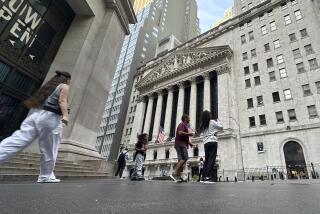‘Stagflation’ Worries Are Mounting
- Share via
With inflation heating up amid the prospect of another interest rate hike from the Federal Reserve, some economists said Wednesday they were beginning to worry about a ghost from the past: stagflation.
Their concern over the dreaded affliction of rising prices in a languishing economy -- last seen in the 1970s -- follows a second day of bad inflation news.
The consumer price index, the prices consumers pay for goods and services, rose 0.4% in May, in line with expectations, the government reported Wednesday. But core consumer prices, which exclude volatile energy and food costs, increased 0.3%, above the expected 0.2%.
A day earlier, the government reported that producer prices excluding energy and food rose faster than expected last month.
The series of bad inflation news makes it all but certain, economists say, that the Fed will raise its key short-term interest rate by 0.25 percentage point to 5.25% when its policy-setting committee meets this month.
A separate Fed survey of regional economic conditions released Wednesday showed that the economy was slowing, led by declines in home sales and manufacturing, and that inflation was on the rise.
Other recent data -- including retail sales, employment and wage data from April and May -- suggest that the Fed’s previous rate hikes are slowing the economy. Economists said more increases by the Fed would run the risk of inducing a recession -- and wouldn’t have much effect on inflation anyway because it was largely driven by the global demand for oil.
“The economy could be facing a bout with stagflation,” said Peter Morici, a University of Maryland business school professor. “My feeling is we’re headed for a tragedy here.”
Dean Baker, co-director of the Center for Economic and Policy Research, said he also viewed stagflation as a possibility as credit tightening further damps the housing market and puts a crimp on the spending of homeowners.
“The May price data provides grounds for concern on several fronts,” he said.
“I think we’re in for some tough times.”
The 0.4% rise in May in the overall consumer price index followed a 0.6% gain in April. The annual rate through May of 5.2% is up from last year’s 3.4%.
The index’s overall increase was driven largely by energy costs, which rose 2.4% in May after gains of 3.9% in April and 1.3% in March. At an annual rate of nearly 31%, energy prices are rising almost twice as fast as last year.
Core consumer prices -- excluding energy and food -- rose at an annual rate of 3.1% through May, up from 2.2% last year.
Owners’ equivalent rent, a measure the government uses to estimate the cost of home ownership, jumped 0.6%, the biggest increase in 16 years. Economists said the rise was partly because people who have been priced out of the home-buying market were pushing up rents. But, they said, the increase may have been exaggerated by a technical quirk in the way the government calculates that part of the index.
President Bush told reporters at the White House that he was confident the Fed would do its job to keep inflation in check.
“Monetary policy will pay attention very carefully to the signs, inflationary signs -- that’s Ben Bernanke’s job,” Bush said Wednesday, referring to the former White House economic advisor he selected to replace Alan Greenspan as Fed chairman.
Last week, Bernanke described inflation growth over the last three months as “unwelcome” in comments that sent the Dow Jones industrial average tumbling 199 points in one day.
After falling for much of the last week, stocks closed up Wednesday as analysts said traders factored in the apparent certainty that the Fed would move its federal funds rate beyond the five-year high of 5% set at the May 10 meeting of the Federal Open Market Committee.
Still, economists cautioned, a rate hike may not cure today’s inflation. That’s because the upward pressure is coming not from rising wages but from high energy prices -- over which U.S. consumption exerts less influence than ever, the University of Maryland’s Morici said.
Giant emerging economies such as China are demanding more of the world’s oil. As a result, the U.S. share is shrinking; today, the U.S. buys 22 million of 84 million barrels sold each day, he said.
Even if the Fed were to raise rates high enough to cut economic growth in half, U.S. demand for oil would shrink by 2% or less -- not enough to drive prices down, Morici said.
“If Mr. Bernanke is worried about the high international price of oil creating inflation in the United States, then he’s trying to put out a forest fire with a pop bottle’s worth of water,” he said.
More to Read
Inside the business of entertainment
The Wide Shot brings you news, analysis and insights on everything from streaming wars to production — and what it all means for the future.
You may occasionally receive promotional content from the Los Angeles Times.











